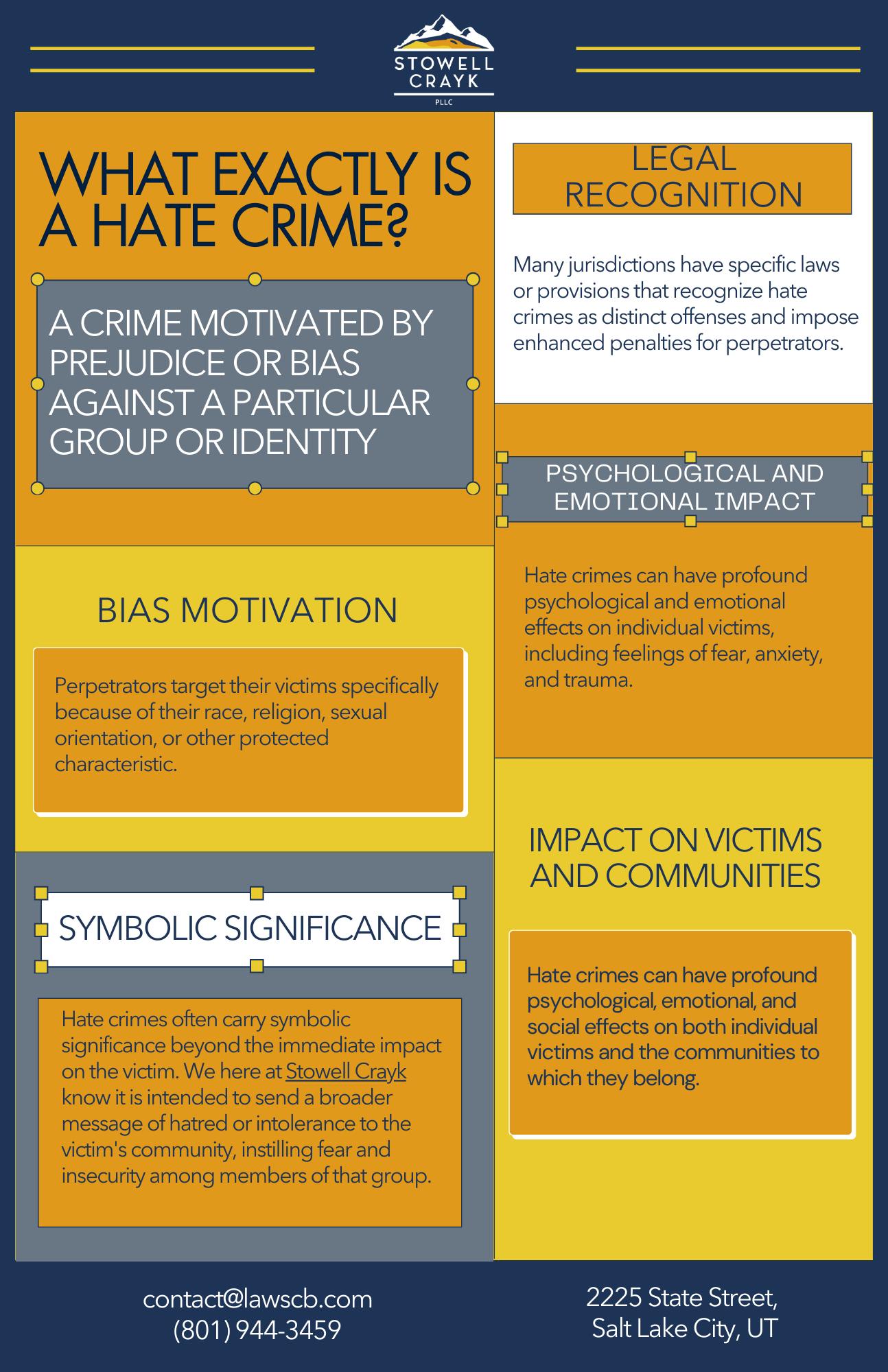In recent years, discussions surrounding hate crimes have become increasingly prevalent in public discourse. However, despite their growing recognition, there still exists a degree of ambiguity and misunderstanding surrounding the concept of hate crimes. We here at Stowell Crayk know What exactly qualifies as a hate crime, and how do they differ from other forms of criminal behavior? In this blog post, we’ll delve into the definition, characteristics, prevalence, and impact of hate crimes, shedding light on this complex and important issue.
Defining Hate Crimes
A hate crime, also known as a bias-motivated crime or bias crime, is a criminal offense committed against an individual or group based on their perceived or actual race, ethnicity, religion, sexual orientation, gender identity, disability, or other protected characteristic. What distinguishes hate crimes from other criminal acts is the underlying bias or prejudice that motivates the perpetrator. In essence, hate crimes are not only attacks on the immediate victim but also deliberate acts of intimidation or violence intended to instill fear and send a message of intolerance to an entire community.
Characteristics of Hate Crimes
Several key characteristics distinguish hate crimes from other forms of criminal behavior:
Bias Motivation:
Hate crimes are motivated by prejudice or bias against a particular group or identity. Perpetrators target their victims specifically because of their race, religion, sexual orientation, or other protected characteristic.
Symbolic Significance:
Hate crimes often carry symbolic significance beyond the immediate impact on the victim. We here at Stowell Crayk know it is intended to send a broader message of hatred or intolerance to the victim’s community, instilling fear and insecurity among members of that group.
Impact on Victims and Communities:
Hate crimes can have profound psychological, emotional, and social effects on both individual victims and the communities to which they belong. They can exacerbate existing tensions, erode trust in institutions, and create a climate of fear and division.
Legal Recognition:
Many jurisdictions have specific laws or provisions that recognize hate crimes as distinct offenses and impose enhanced penalties for perpetrators. These laws reflect society’s recognition of the unique harm caused by hate-motivated violence and the need to deter and punish such behavior effectively.
Prevalence and Impact of Hate Crimes
Hate crimes, though often hidden beneath the surface of society, are a persistent and troubling reality in communities worldwide. While accurate data on the prevalence of hate crimes can be challenging to obtain due to underreporting and varying definitions across jurisdictions, research and anecdotal evidence suggest that these offenses remain a significant concern in many countries.
One of the defining features of hate crimes is their impact, which extends far beyond the immediate victims to affect entire communities and society as a whole. At Stowell Crayk, we understand these crimes strike at the heart of social cohesion and undermine the principles of equality and justice. Here’s a closer look at the prevalence and impact of hate crimes:
Underreported Incidents:
Many hate crimes go unreported, either because victims fear retaliation or because they lack confidence in the criminal justice system’s ability to address their concerns. Additionally, some victims may not recognize or acknowledge the biased motivation behind the crime, further complicating efforts to track and address hate-motivated offenses.
Targeted Communities:
Hate crimes disproportionately target marginalized and vulnerable communities, including racial and ethnic minorities, religious minorities, LGBTQ+ individuals, and people with disabilities. These communities often face systemic discrimination and prejudice, making them more vulnerable to hate-motivated violence and harassment.
Psychological and Emotional Impact:
Hate crimes can have profound psychological and emotional effects on individual victims, including feelings of fear, anxiety, and trauma. Victims may experience heightened levels of stress and hypervigilance, fearing further attacks or retaliation. These psychological scars can endure long after the physical wounds have healed, contributing to long-term emotional distress and mental health challenges.
Social Division and Mistrust:
Hate crimes exacerbate social divisions and erode trust between different groups within society. They create an atmosphere of fear and suspicion, pitting communities against each other and undermining efforts to foster dialogue and understanding. In the aftermath of a hate crime, affected communities may experience heightened tensions, increased polarization, and a breakdown of social cohesion.
Impact on Society:
Hate crimes have broader societal implications, affecting not only the immediate victims and their communities but also society as a whole. They undermine fundamental principles of equality, diversity, and inclusion, threatening the fabric of democratic societies and eroding trust in institutions. Hate-motivated violence and discrimination hinder efforts to build a more just and inclusive society, perpetuating cycles of prejudice and intolerance.
Addressing Hate Crimes: Prevention and Response
Addressing hate crimes requires a multifaceted approach that combines prevention, enforcement, education, and community engagement. Key strategies include:
Enhancing Legal Protections:
Strengthening and enforcing laws against hate crimes to ensure perpetrators are held accountable for their actions and victims receive justice and support.
Promoting Awareness and Education:
Raising awareness about hate crimes and their impact through education, training, and public outreach initiatives. This includes educating law enforcement, policymakers, and the public about the nature of hate crimes, their prevalence, and strategies for prevention and response.
Supporting Victims and Communities:
Providing support services, resources, and assistance to victims of hate crimes and their communities. This may include counseling, legal assistance, advocacy, and community-based initiatives to promote healing and resilience.
Fostering Inclusion and Understanding:
Promoting social cohesion, diversity, and inclusion through efforts to combat prejudice, discrimination, and bigotry. This includes fostering dialogue, promoting tolerance and understanding, and challenging stereotypes and misconceptions that fuel hate-motivated attitudes and behaviors.
Conclusion
Hate crimes represent a grave violation of fundamental human rights and pose a significant threat to social cohesion, equality, and justice. By understanding the nature and impact of hate crimes and taking proactive steps to prevent and address them, we can work towards building a more inclusive, tolerant, and resilient society. It is incumbent upon all of us to stand against hate in all its forms and uphold the principles of equality, dignity, and respect for all individuals, regardless of their race, religion, ethnicity, or other protected characteristics.

